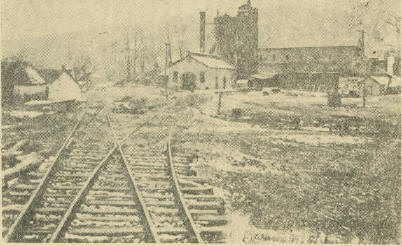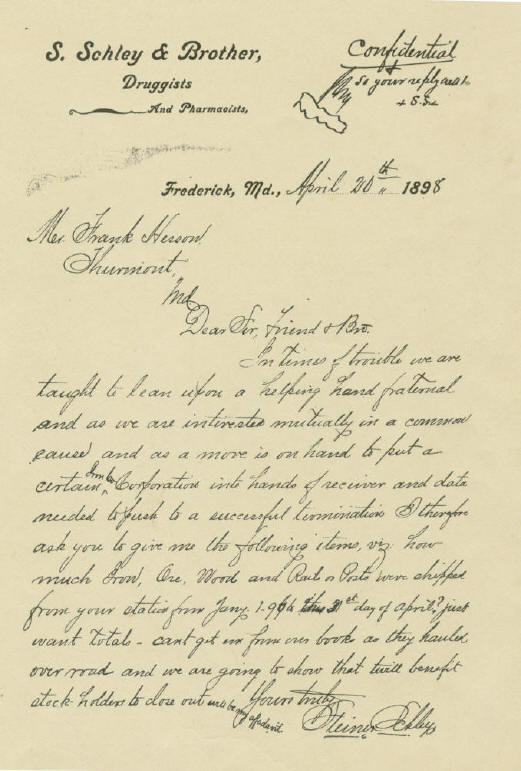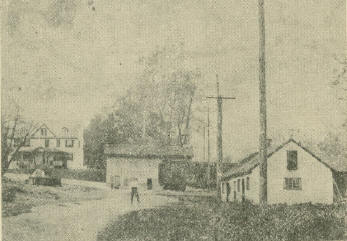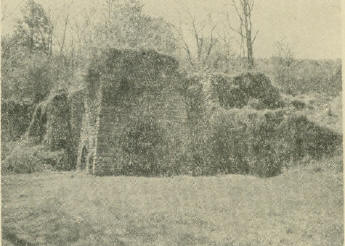Located about three
miles south of
Thurmont, on US Route
15, is the thriving
little community of
Catoctin Furnace.
Nestled in the valley
at the base of the
beautiful Catoctin
Mountains, this little
village was once the
scene of much
activity, for it was
here that the Catoctin
Iron Works was first
established and in
later years it
contributed much to
the history of early
America.
In 1768, a grant of
land consisting of
7,000 acres was given
by Leonard Calvert to
Thomas Johnson and
Launcelot Jacques for
the specific purpose
of establishing a
forge mill. This
operation soon became
very successful and
gave employment to
many persons in the
immediate area.
The discovery of iron
ore in the Catoctin
Mountains soon led to
the building of a
smelting furnace. A
dozen or more houses
were built along the
turnpike for the
workers and the
village of Catoctin
soon became a behive
of activity. Great
open spaces were made
in the mountain where
the old trees were
burned into charcoal,
and then hauled down
the mountain by
four-mule teams to the
hearths of the
furnace, where it was
used in the process of
turning the ore into
pig-iron.
 |
|

Scenes of Catoctin
Iron Works 1895 |
By 1773 Launcelot
Jacques withdrew his
interests at Catoctin
and built his own
furnace across the
mountain. Thomas
Johnson was then
joined by his
brothers, Baker, Roger
and James and a second
furnace was
constructed to meet
the growing demands
for pig-iron.
During the American
Revolution, this
prosperous little
industry had the honor
of making cannon, shot
and shell for General
George Washington's
army while he was
engaged in the battle
of Yorktown. It was
several years later
while conducting
experiments with a
steam-boat that James
Rumsey visited the
"Furnace" and
personally supervised
the casting of several
parts for his ship,
the first vessel
propelled by steam in
American waters. A
large imperfect
casting stood for
years imbedded in the
ground near the
cross-roads.
As the iron works grew
in importance,
Catoctin House was
built for Thomas
Johnson, who was the
leading figure and
superintendent of the
furnace. Today this
house is a pitiful
ruin, staring with
vacant eyes upon what
was once the scene of
great activity. In
1803 Baker Johnson
took over the
operations of the
business and Thomas
Johnson withdrew his
interests and entered
politics, later
becoming the first
governor of the State
of Maryland. What a
shame that some of our
historical societies
haven't taken enough
interest in the site
to preserve Catoctin
House as a monument to
the first governor of
Maryland.
Baker Johnson, like
his brother Thomas,
wanted a big home and
in 1805 he built a
beautiful house at
Auburn Farm where he
lived for a number of
years. Near the
gateway to the
driveway to Auburn was
a small forge where
castings were made.
Several years ago when
the State widened the
road, a number of
cannon balls were
plowed out of the old
site along with
several iron wedges
used to direct the
flow of molten iron
when it was run off in
the casting house. To
the left of the
driveway, stood a
warehouse of charcoal.
Even today, the soil
at this site is still
blacker than anywhere
else in the area.
Baker Johnson at one
time leased the iron
works to Blackford and
Thornburg, but before
the expiration of
their lease, Mr.
Johnson died and the
business was sold to
Welloughly and Thomas
Mayberry in 1813.
Seven years later the
property changed hands
again and was
purchased by John
Brien and his
brother-in-law John
McPherson, who made
many improvements
which increased its
capacity. Tin plate
stoves and the popular
Franklin stoves were
,cast at Catoctin
during the Brien
ownership. The tin
plate stoves were very
popular at the time
for they permitted the
burning of full-length
cord wood. The
Franklin stoves were
made to fit into
fireplaces, some of
which are still
preserved and bear the
inscription "McPherson
and Brien, Catoctin
Furnace."
By 1852 the Catoctin
Iron Works was under
the ownership of James
P. Fitzhugh and Jacob
M. Kunkel. In 1855 the
Fitzhughs decided to
go to California and
shortly after their
departure, Jacob
Kunkel sold the
business to his two
sons, John B. and John
M.
Kunkel. In 1885 John
B. Kunkel died and
John M. continued the
business alone. He
later added 4,000 more
acres to the property
and another furnace
was erected. Abundant
iron ore of the best
quality of hemetite
was found on the land
and it was during this
period that the
Catoctin Iron Works
produced about 12,000
tons of fine pig-iron
annually. This was
used in the
manufacture of car
wheels and for all
foundry and rolling
mill purposes.
March 9, 1862 was a
very important day to
the people of Catoctin,
for it was on this day
that the Monitor
engaged the Merrimac
in the battle at
Hampton Roads,
Virginia.
The Monitor, an
armored naval vessel,
was designed by and
constructed under the
direction of the
American engineer,
John Ericsson. The
vessel was propelled
by steam and had guns
mounted in a revolving
armored turret. The
freeboard of the
vessel was low and the
turret was small in
comparison with the
over-all length;
because of its shape
the vessel was
divisively called by
the Confederates the
"Yankee cheese box on
a raft."
On March 9, 1862 the
Monitor met up with
the Merrimac at
Hampton Roads,
Virginia, where the
previous day the
Merrimac had destroyed
several wooden Federal
vessels. The Monitor,
lighter and less
unwieldy than its
opponent, was able to
outmaneuver the
Merrimac. The battle
between these two
ships lasted several
hours, with the
Merrimac finally
withdrawing up the
Elizabeth River.
Al-though the relative
fighting capacity of
the two ships was not
conclusively
determined by the
battle, it was a
strategic victory for
the Monitor, as the
ships of the Federal
fleet were protected
from further attack by
the Merrimac.
Furthermore, the
battle showed the
superiority of
ironclad ships over
the wooden ships used
up to that time.
The people of Catoctin
Furnace were deeply
impressed by the
results of this Civil
War battle and
rightfully so, for the
plates of the Monitor
were made from the
iron produced at the
Catoctin Iron Works.
During the Civil War,
work at the furnace
was never interrupted,
even when the Union
Army marched through
Catoctin on its way to
Gettysburg. For days
after the Battle of
Gettysburg, many tired
soldiers from both
sides wandered back
through the
countryside and were
fed and comforted by
the citizens of
Catoctin. Some were
even offered jobs at
the furnace.
Following the war, a
new industry — a paint
mill — was established
at Catoctin. This
brought an influx of
people to the village
and a number of new
homes were built in
the area. By this time
Kunkel had over 440
men on his payroll.
To transport supplies
to the furnace and
pig-iron to Thurmont
for shipment via the
Western Maryland
Railway, six and eight
teams of mules would
haul sturdy wagons
over the dirt roads.
In snowy and rainy
weather the weight of
the wagons made
traveling very
difficult. The need
for a smoother and
faster means of
transportation
necessitated the
building of a
railroad.
In 1886 the Monocacy
Valley Railroad was
organized by L. R.
Waesche of
Mechanicstown and Dr.
Steiner Schley of
Frederick. Work was
begun immediately and
the four mile road
connecting the
Catoctin Furnace with
the Western Maryland
Railway at
Mechanics-town was
completed the same
year. The teams of
mules continued to be
the source of power
until 1898 when a
steam locomotive was
purchased. The engine
took over the hauling
to and from the West-ern
Maryland Railway at
Mechanicstown and was
also used in moving
the standard gage cars
about at the furnace.
Around 1900 there was
great activity at the
Catoctin Iron Works
and the Monocacy
Valley Railroad
purchased a narrow
gage engine to haul
the cars that
delivered the ore to
the washers at the
upper level. Here the
ore was washed and
then moved by the
standard gage engine
to the stock house. At
one time there were
fourteen sidings at
the Furnace to handle
the raw materials and
the finished products.
This expansion
necessitated the
construction of a
third siding by the
Western Maryland
Railway at Thurmont in
order to handle the
large volume of
business there.
As an indication of
the large volume of
business handled by
the Monocacy Valley
Railroad, a copy of
the Catoctin Clarion,
dated June 7, 1900,
revealed that in May
of that year the
Western Mary-land
delivered to the
Monocacy Valley, 91
cars of coke, 23 cars
of limestone, 1 car
load of coal, 1 car of
rails and two cars of
sup-plies. In turn
Monocacy Valley
delivered to the
Western Mary-land, 128
cars of pig-iron
produced at Catoctin.
In June 1905, tragedy
struck Catoctin. A
flat car loaded with
workers was being
hauled up the line and
as a result of an
error in signals, a
fast train crashed
into it. Almost every
family suffered the
loss of a father, a
son or a brother.
On April 20, 1898, in
a letter to Mr. Frank
Hesson, Agent for the
Western Maryland
Railway at Thurmont,
Steiner Schley clearly
indicated that a move
was being considered
to place the Catoctin
Iron Works into the
hands of receivership.
He requested
information concerning
how much iron, ore,
wood, rails, and posts
were shipped from
Thurmont from January
1, 1897 to April 20,
1898. Mr. Schley's
letters, reproduced
here in their original
form indicated that
this information was
not available from the
books at the Furnace
and he needed them to
show that it would
benefit the
stockholders to close
out.

This letter, found by
the author in the
ruins of the old
Western Maryland
station when it was
being demolished in
1967, is proof that
business conditions
were not what they
seemed to be. Work was
slowing down at the
Furnace. Other plants
of this nature were
being established near
the great industrial
centers where
operating costs were
cheaper and
transportation
problems fewer. The
paint mill closed and
many of the village
men found work on the
Western Maryland
Railroad.
|

Catoctin House as
it appeared around
1900 |
Finally by 1907, the
Catoctin Iron Works
went into the hands of
receivership and was
sold, this time to a
Pennsylvanian, Mr.
Thropp, who soon
closed it completely.
The end had finally
come. All of the
machinery was moved to
his other plant near
Pittsburgh.
On December 7, 1907,
the Frederick Railroad
Company was chartered
under the laws of
Maryland. Among the
railroads absorbed by
the Frederick Railroad
Company were the
Monocacy Valley
Railroad, and the
Washington, Frederick
and Gettysburg
Railroad. The Monocacy
Valley as a
corporation went out
of existence and the
operation of the
Monocacy Valley as a
separate segment
ceased.
|

Catoctin Furnace
as it looks today |
In 1923 the furnace
property was sold on a
mortgage to Launcelot
Jacques, a descendant
of the first owner,
and his partner
Stanley Hauver. The
tenants of the houses
on the property were
given the option to
buy their homes and
today, many of them
are still owned by the
third and fourth
generations.
Several years later
some of the furnace
acreage was sold, a
portion of which was
purchased by Lawrence
Richey, then secretary
to President Herbert
R. Hoover. A camp was
built on the site and
a cabin was erected
for the President.
President Hoover spent
many week-ends here,
but disliked the
publicity which he
received every time he
came to Catoctin.
Since he was unable to
close the country road
which led to the
Richey camp, he
withdrew to Rapidan,
near Madison,
Virginia, where he
spent his weekend
outings.
|

Sandy Hole, a
favorite spot for
picnics, fishing
and swimming |
In the early part of
the 1930's, the
Federal Government
purchased 5,000 acres
of the mountain land
including Catoctin
House, for the purpose
of establishing the
Catoctin Recreation
Demonstration Area.
Catoctin House had
been vacant for many
years prior to this
and was badly in need
of repair. Many
citizens were led to
believe that the
National Park Service
would restore the old
Thomas Johnson home as
a memorial to
Maryland's first
governor, but this has
never materialized.
The beautiful boxwood
which lines the walk
at Catoctin House was
removed. Some of it
was re-planted at the
White House and some
at the Lincoln
Memorial. The old
house itself was found
to be in such bad
condition that nothing
was ever done to
preserve it. Today all
that remains of this
historic site is the
old stone walls which
can hardly be seen
from the road for the
thick undergrowth that
has grown up around
it. Nature has almost
obliterated all trace
of its former activity
and the important part
it must have played in
the development and
progress of the once
famous Catoctin Iron
Works.
Chapter Index
|
Chapter 4: The Tanning
Industry
Read other articles by George Wireman